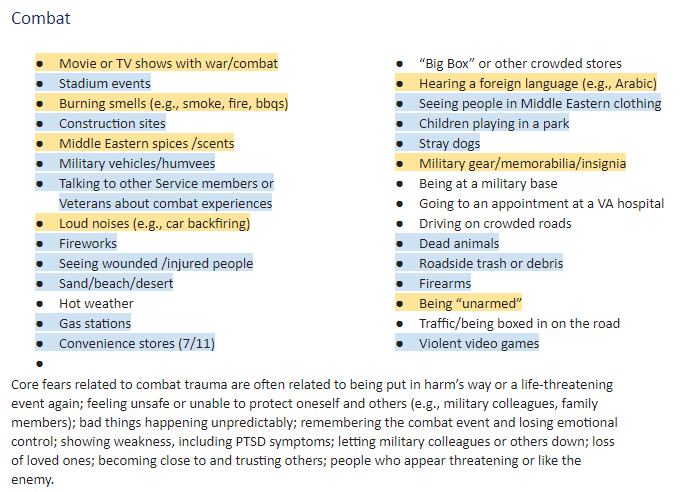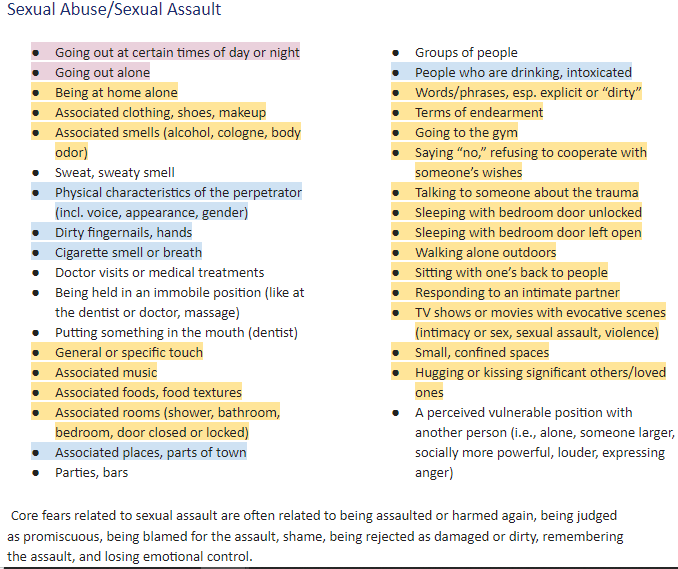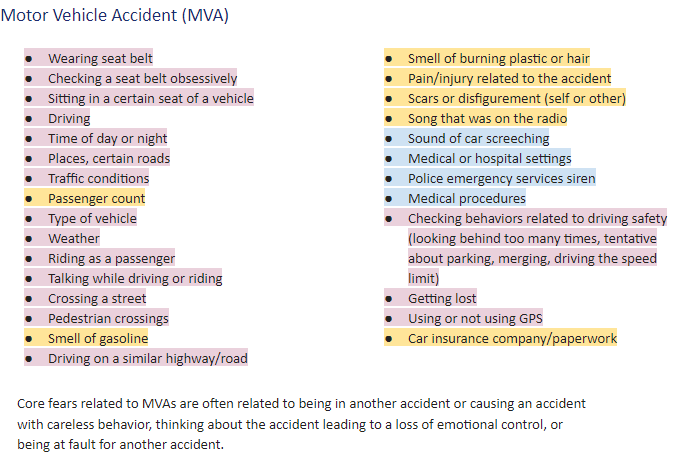 Below are the ”Sample In Vivo Items” from our PE Training Supplement handout. These include sample in vivo exposure items for combat trauma, sexual trauma, motor vehicle accidents and natural disaster. (Click on any of the images for a larger version) They were intended to give workshop participants ideas about things clients may avoid when they have experienced a particular type of trauma. Real clients will work with you to generate their own lists but the sample lists represent a broad array of the types of items clients may include.
Below are the ”Sample In Vivo Items” from our PE Training Supplement handout. These include sample in vivo exposure items for combat trauma, sexual trauma, motor vehicle accidents and natural disaster. (Click on any of the images for a larger version) They were intended to give workshop participants ideas about things clients may avoid when they have experienced a particular type of trauma. Real clients will work with you to generate their own lists but the sample lists represent a broad array of the types of items clients may include.
At first glance, about a third to half of the items on the list are accessible without leaving the house and without any modification at all. These items are highlighted in yellow.
A second category of items involve travel outside the house but do not involve public contact. These items are highlighted in pink. Depending on the level of restriction clients may need to do these less frequently than normal times, but they may still be accessible in some areas.
 Many items can be confronted, at least initially, via technology. We often begin exposures using this type of media because it provokes less distress than live confrontation and these exposures can be done at home. Once restrictions are relaxed the client can progress to live situations that provoke more intense distress. Analog or technology resources items are highlighted in blue.
Many items can be confronted, at least initially, via technology. We often begin exposures using this type of media because it provokes less distress than live confrontation and these exposures can be done at home. Once restrictions are relaxed the client can progress to live situations that provoke more intense distress. Analog or technology resources items are highlighted in blue.
In the unhighlighted group, there are a few items that require live confrontation with other people to evoke the necessary response. For these items, you can ask about the specific emotion or outcome the client is avoiding, and brainstorm about other situations to which the client may have similar reactions. We routinely ask this question in PE to vary the context of exposures in order to deepen learning, but it also may assist you in uncovering other ways to do exposure to the same avoided emotion or outcome. If you are unable to come up with analogous situations the exposure will need to wait until restrictions are lifted, but it is worth noting that these items are much fewer in number than the other types of items.
 Most important, remember that PTSD isn’t taking a break because your client’s lifestyle is altered due to physical distancing. Anxiety related to some cues will decrease because there are fewer opportunities to be triggered by stimuli out in the community. Other cues will be intensified or new ones discovered because the context has radically changed. For example, disconnection with family members may be more intense because there is more opportunity to notice it, while lack of peace and privacy may increase irritability. These are opportunities to add to the hierarchy and target those situations specifically.
Most important, remember that PTSD isn’t taking a break because your client’s lifestyle is altered due to physical distancing. Anxiety related to some cues will decrease because there are fewer opportunities to be triggered by stimuli out in the community. Other cues will be intensified or new ones discovered because the context has radically changed. For example, disconnection with family members may be more intense because there is more opportunity to notice it, while lack of peace and privacy may increase irritability. These are opportunities to add to the hierarchy and target those situations specifically.
Likewise, there will be greater opportunity to practice in vivo with family members than before. So, while interactions with some people may be more limited, sheltering in place may open up more opportunities for others, e.g., helping children with homework, staying at the dinner table longer than usual, watching a TV show together, playing a board game or doing chores together.
 Seek consultation for help untangling these new challenges. We are better at this when we tackle it as a community than if we tackle it alone. At CDP we are available by email, telephone or video-conference. We also hold an open consultation meeting on Thursdays. If you would like a calendar invite to that meeting shoot an email to peclc@deploymentpsych.org.
Seek consultation for help untangling these new challenges. We are better at this when we tackle it as a community than if we tackle it alone. At CDP we are available by email, telephone or video-conference. We also hold an open consultation meeting on Thursdays. If you would like a calendar invite to that meeting shoot an email to peclc@deploymentpsych.org.
